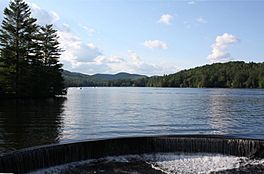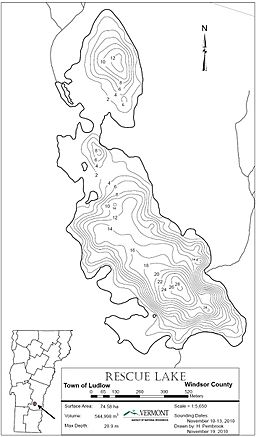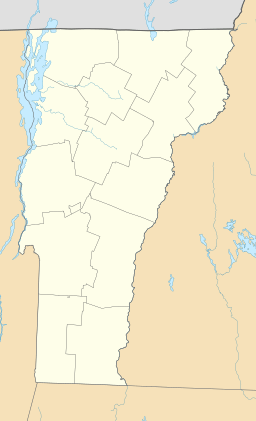Lake Rescue (Vermont) facts for kids
Quick facts for kids Lake Rescue |
|
|---|---|

Lake Rescue and the horseshoe dam, looking north from Red Bridge
|
|

Lake Rescue Depth Chart, prepared by Vermont ANR
|
|
| Location | Windsor county, Vermont, United States |
| Coordinates | 43°27′05″N 72°42′08″W / 43.4514601°N 72.7023191°W |
| Type | Reservoir |
| Primary inflows | Black River |
| Primary outflows | Black River |
| Basin countries | United States |
| Max. length | 5,900 feet (1.8 km) |
| Max. width | 2,200 feet (0.67 km) widest point |
| Surface area | 184 acres (0.74 km2) |
| Average depth | 24 feet (7.3 m) |
| Max. depth | 95 feet (29 m) |
| Water volume | 4,416 acre-feet (5,447,000 m3) |
| Surface elevation | 1,043 feet (318 m) |
| Settlements | Ludlow |
Lake Rescue is a beautiful lake found in Windsor County, in south-central Vermont, United States. It covers about 180 acres (73 ha) (which is like 136 football fields!). The lake is quite deep, reaching 95 feet (29 m) at its deepest point. This makes it the tenth-deepest and 23rd-largest lake in Vermont.
Lake Rescue is located near Ludlow and Okemo Mountain. It's along Vermont Route 100, about three miles north of Ludlow. The Black River flows into and out of Lake Rescue. This lake is part of a chain of four lakes that stretch from Plymouth, Vermont through Ludlow. To the north are Lake Amherst and Echo Lake, and to the south is Lake Pauline. A part of Lake Rescue to the north, connected by a shallow area, is called Round Pond.
Contents
Fun Activities at Lake Rescue
Lake Rescue is a popular spot all year round for people who live nearby. About 110 homes and camps are located right by the lake.
Summer Fun on the Lake
In the summer, people enjoy many water activities.
- Swimming
- Waterskiing
- Fishing
- Sailing
There are no public swimming beaches. However, there is a public fishing access point. Here, you can launch your boat into the lake. You can park on Red Bridge road between Lake Shore drive and East Lake Road.
Winter Fun on the Lake
When winter arrives and the lake freezes, new activities begin!
- Ice-fishing
- Ice skating
- Snowmobiling
Fishing in Lake Rescue
Lake Rescue is home to many types of fish. You might catch:
- Bass
- Perch
- Brown trout
- Rainbow trout
- Pickerel
- Sunfish
Red Bridge and Lake Rules
A special "horseshoe" shaped dam separates Lake Rescue from Lake Pauline. The famous Red Bridge crosses over this dam. Lake Rescue is north of Red Bridge, and you can use power boats there. However, jet skis are not allowed. South of Red Bridge, on Lake Pauline, only boats that don't use motors are allowed.
Understanding Lake Rescue's Water Quality
The Vermont Agency of Natural Resources checks the water quality of lakes in Vermont. Here's what they found about Lake Rescue in 2015:
Lake Classification and Type
- The water quality is rated as "B".
- Lake Rescue is a natural lake, but it has a man-made control (the dam).
Lake Measurements
- The lake covers 184 acres (74 ha).
- The area of land that drains into the lake (watershed) is 22,859 acres (9,251 ha).
- The deepest part of the lake is 95 feet (29 m).
- The average depth is 24 feet (7.3 m).
- The total amount of water in the lake is 4,416 acre-feet (5,447,000 m3).
Land Use Around the Lake
Most of the land around the lake is undeveloped.
- 98% is undeveloped land.
- 2% is developed land (like homes and roads).
Water Quality Monitoring
Scientists check the water for certain things:
- The average amount of phosphorus in spring is 8.57 ug/l. This is based on 17 years of data.
- The average Secchi disk measurement is 13 feet (3.9 m). This measures how clear the water is.
- The average amount of phosphorus in summer is 12.40 ug/l.
- The average amount of chlorophyll-a is 4.22 ug/l. Chlorophyll-a is a green pigment found in algae.
- The lake's trophic state is "mesotrophic." This means it has a medium level of nutrients and plant growth.
Protecting Lake Rescue from Invasive Plants
Lake Rescue faces a challenge from an invasive plant called Eurasian milfoil. This plant can grow very fast and harm the lake's natural environment.
The Discovery of Milfoil
In 1998, 70 milfoil plants were found in the Round Pond section of the lake. Since then, people have been working hard to stop this plant from spreading.
Efforts to Remove Milfoil
The Lake Rescue Association (LRA) has been leading the fight against milfoil.
- Since 1999, the LRA has hired scuba divers. These divers search for and remove milfoil plants by hand from Lake Rescue, Round Pond, and Lake Pauline.
- From 1999 to 2003, divers removed about 100 milfoil plants.
- Lake Rescue was free of milfoil from 2004 until recent years.
- In 2011, Tropical Storm Irene brought a lot of dirt into the lake. This made it hard to find milfoil in 2012 and 2013.
- The first new milfoil plant was found again in 2013.
- Since 2014, the LRA has increased the number of days divers work.
- In 2016, divers searched the entire lake twice a week during the summer.
- The LRA also teaches lake users about milfoil and checks boats at public access points.
The Story Behind Lake Rescue's Name
The lake we know today as Lake Rescue was made larger in 1835. A dam was built at its southern end to create water power. By the early 1900s, it became a popular summer vacation spot.
Old Stories and Legends
An old newspaper clipping from the Black River Academy Museum tells two stories about how Lake Rescue got its name.
Captain Coffin's Rescue
One story is about Captain Coffin. He lived in Cavendish during the Revolutionary War. One snowy March day, he was crossing the frozen lake on snowshoes. He fell into a hidden air hole in the ice. He was strong, but his heavy clothes and snowshoes made it impossible to get out alone. Luckily, his dog showed amazing intelligence and helped him get out of the icy water. Captain Coffin often told the story of how his dog saved his life.
The Lost Child's Rescue
The other story is likely the one that inspired the lake's name. A child from a Cavendish settler's home wandered off and got lost in the woods. Search parties looked for days. They finally found the child on a rock on the eastern shore of the lake. The child was calm, even after being lost for several days and nights. The child said they spent one night with a "big black sheep and two lambs" that kept them warm. People believe the "black sheep" was actually a friendly black bear and her cubs.
How the Lake Was Named
In August 1881, about 150 people gathered on the shore of the lake. They officially renamed "Plymouth Lake" to "Lake Rescue," likely because of these stories of survival and help.
The Lake Rescue Association
The Lake Rescue Association (LRA) is a group formed in 1933. It's open to all property owners around Lake Rescue and Lake Pauline. The LRA works to:
- Promote safety on the water.
- Educate people about the environment.
- Improve the water quality of the lakes.
- Help solve important issues for its members.



